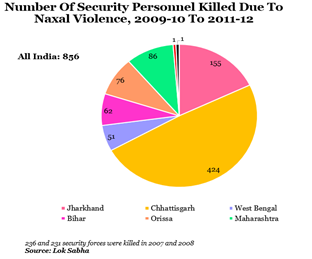

25th July 2022 (7 Topics)
Context
The National Investigating Agency (NIA) court in Dantewada acquitted 121 tribals, including a woman, who were arrested in connection with a suspected 2017 Maoist attack that claimed the lives of 25 security personnel in Chattisgarh’s Sukma district.
Background
- On April 24, 2017, a combined patrolling party — comprising 72 jawans from the Central Reserve Police Force (CRPF)’s 74th battalion and district police were guarding a road cum bridge construction in Sukma’s Burkapal when they were ambushed by a large group of 200-250 alleged Maoists.
- This was the second deadliest Naxalite attack in terms of casualties.
- The investigators alleged that the arrested villagers were members of the banned CPI (Maoist) Party.
- The prosecution also submitted that they had been in possession of weapons.
- All 121 accused were charged with Sections 147 (rioting), 148 (rioting, armed with deadly weapon), 302 (murder), 149 (unlawful assembly), 307 (attempt to murder) 396 (dacoity), 397 (robbery, armed with deadly weapon) and 120 (B) (criminal conspiracy) of the Indian Penal Code, 1860.
- They were also charged with provisions of the Chhattisgarh Special Public Security Act (CSPSA), 2005 and Unlawful Activities (Prevention) Act (UAPA), 1967 that prohibit taking membership of an unlawful organisation (CPI (Maoist) in the given case and indulging in any unlawful activity for it.
- Apart from this, provisions of the Arms Act, 1959, and Explosives Act, 1908 were also slapped.
- Then began the tribals’ long struggle for justice. The village rallied around to fight for the men in jail.

About the Judgement
- NIA presented before the court that 22 (of the 25) prosecution witnesses were neither aware of the incident nor did they know the accused.
- Even after those witnesses were declared hostile by the prosecution and subjected to direct questions, no fact about the incident had emerged while they were being examined.
- Thus the prosecution has not been able to prove its case beyond doubt.
- Court has ordered to leave them as there was no evidence against them after suffering five years in Jail.
|
Tribals affected in the Region
|
Vulnerability of Locals in the Naxalite affected regions
- Displacement: Frequent attacks in these region lead to displacement of several tribals in the region leaving their native place.
- Increase in Crime rate: It leads to increase in crime rate in the region merely on the grounds of suspicion, in self-defence by tribals.
- Possibility of joining Naxal groups: Due to lack of adequate facilities and unemployment, they may choose to actually join the groups which can use them against their development.
- Often seen as accused in their own place: Tribals of the Naxal prone areas are often termed as accused to be Naxals themselves, which causes their social stigmatization.

Government Interventions
- Operation Green Hunt: It was started in 2010 and massive deployment of security forces was done in the naxal-affected areas.
- From 223 districts that were affected due to naxalism in the year 2010, the number has come down to 90 in nine years.
- Aspirational Districts Programme: Launched in 2018, it aims to rapidly transform the districts that have shown relatively lesser progress in key social areas.
- Continuous efforts of government have reduced the frequency of violent attacks in the naxalism-affected regions.
- The government even started ‘Relief and Rehabilitation Policy’ for bringing naxalites into mainstream.



